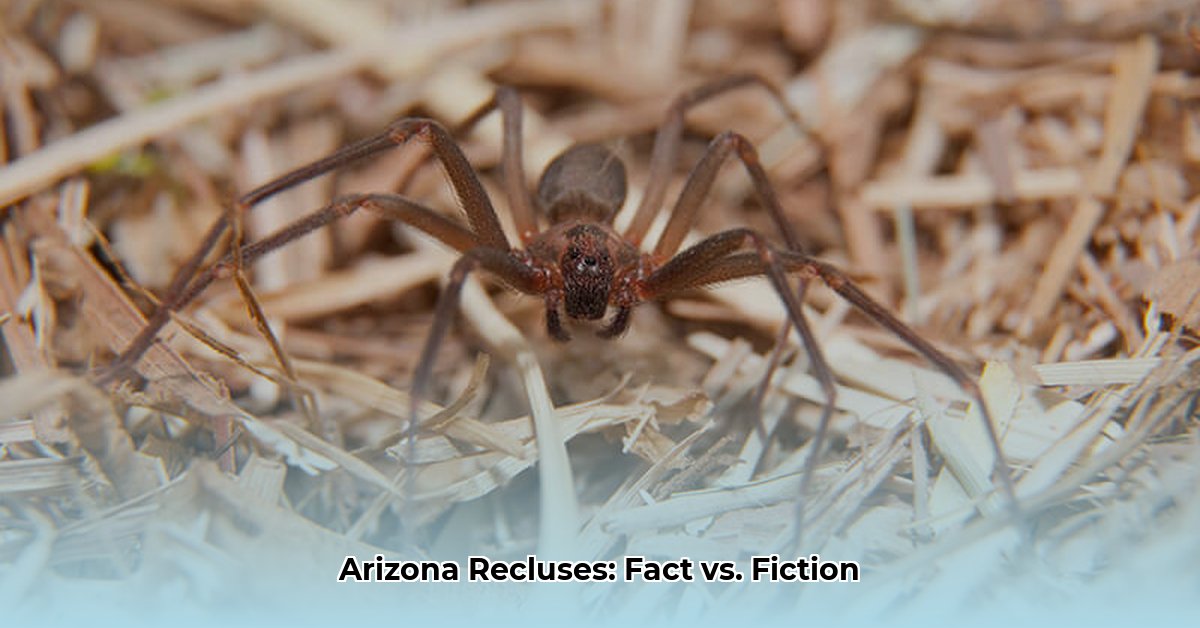The Myth of the Brown Recluse
Let’s clear the air: true brown recluse spiders are exceedingly rare in Arizona. While many Arizonans believe they’ve encountered a brown recluse, it’s almost always a case of mistaken identity. The spiders often blamed are usually the Arizona recluse (Loxosceles arizonica) or the desert recluse (Loxosceles deserta), or even entirely different species.
Identifying Arizona’s Recluses
So, how do you identify Arizona’s actual recluse spiders? Both the Arizona and desert recluse are small, typically about the size of a dime (around ⅓ inch body length) with legs spanning about an inch. Their color ranges from tan to light brown. They may have a faint, sometimes barely visible, violin-shaped mark on their cephalothorax (the fused head and chest region). However, this marking can be very subtle and is not a reliable identifier on its own.
The most distinctive feature of recluse spiders, including Arizona’s species, is their eye arrangement: six eyes arranged in three pairs (dyads). Most other spiders have eight eyes. A magnifying glass might be helpful for this close inspection, but exercise caution when approaching any spider.
Here’s a comparison table:
| Feature | Arizona Recluse | Desert Recluse | Brown Recluse |
|---|---|---|---|
| Color | Tan to light brown | Tan to light brown | Darker reddish-brown |
| Violin Marking | Often faint, might be hard to see | Sometimes clearer, but still can be faint | Distinct dark brown |
| Size | About ¼ to ½ inch long | Roughly the same size | Similar to AZ recluses |
| Eyes | Six, in three pairs | Six, in three pairs | Six, in three pairs |
| Habitat | Houses, sheds, woodpiles, cluttered areas | Deserts, undisturbed places | Primarily Midwestern and Southern US |
| Prevalence in AZ | Relatively common | Less common, primarily in desert regions | Extremely Rare |
Other Common Arizona Spiders Often Mistaken for Recluses:
Several other Arizona spiders are frequently misidentified as recluses. These include:
- Giant house spider ( Eratigena atrica): Large, fast-moving spiders often found indoors. They are generally harmless.
- Striped wolf spider ( Rabidosa rabida): These have distinct stripes and are active hunters, not web-builders. They are not considered dangerous to humans.
- Southern house spider ( Kukulcania hibernalis): Often found in dark corners of homes, the males are sometimes mistaken for brown recluses due to their brown color and elongated shape.
Bites: Fact vs. Fiction and What to Do
Recluse spider bites are often over-reported and misdiagnosed. Bites themselves are often painless initially and may go unnoticed for hours. Symptoms, if they develop, can include redness, swelling, and a blister or ulcer, sometimes with a dark center. However, many skin irritations and other medical conditions can mimic recluse bites.
Important: If you suspect a spider bite of any kind, do not attempt self-treatment or rely on home remedies. Seek medical attention promptly. A physician can diagnose the issue accurately and provide appropriate treatment. If possible, try to collect the spider (even if it’s damaged) for identification.
First Aid for Suspected Spider Bites:
- Cleanse: Wash the bite area gently with soap and water.
- Cool: Apply a cool compress to reduce swelling and alleviate pain.
- Elevate: If the bite is on an arm or leg, elevate the limb.
- Seek Medical Care: Prompt medical evaluation is crucial for any suspected spider bite.
Recluse Control: Prevention is Key
The best way to manage recluses is to make your home less attractive to them. Here are some practical steps:
- Declutter: Regularly clean and declutter, especially storage spaces, closets, garages, and basements. This eliminates hiding spots.
- Seal: Seal cracks and crevices in walls, floors, and foundations. This restricts their entry points.
- Store Smartly: Keep clothing, bedding, and other items in sealed containers, especially if stored in undisturbed areas. Shake out items before use.
- Firewood Management: Store firewood outdoors, elevated off the ground, and away from the house.
- Regular Cleaning: Vacuum and dust frequently to remove spiders, webs, and potential prey.
- Professional Pest Control: For suspected infestations, consult a qualified pest control professional. They can assess the situation and recommend appropriate treatment strategies.
Ongoing Research
While much is known about Arizona’s recluse spiders, research continues. Scientists are investigating various aspects of their behavior, venom, and potential health impacts of bites. Staying informed about the latest research can empower you to make informed decisions about prevention and management.
By understanding the facts about Arizona’s recluse spiders, you can replace fear with knowledge and take proactive steps to minimize the risk of encounters and bites.
- Mini Bento Boxes For Packing Kids Snacks And Small Meals - December 27, 2025
- Small Bento Box Makes Packing Lunch Easy and Fun Again - December 26, 2025
- Adult Bento Box Lunch Ideas For Quick Healthy Portable Options - December 25, 2025










